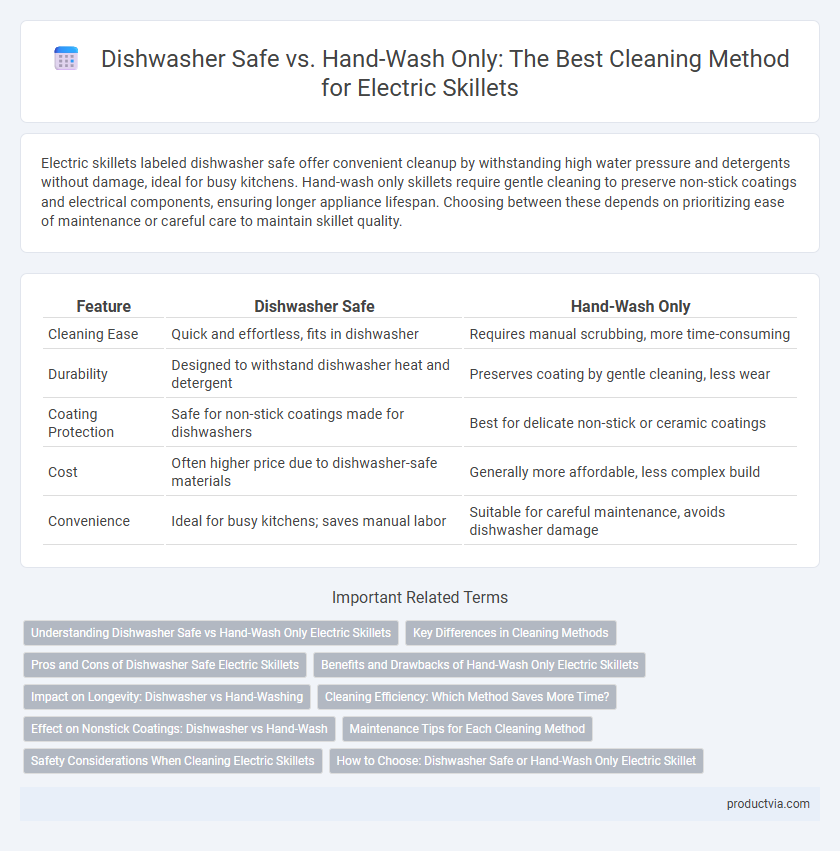Electric skillets labeled dishwasher safe offer convenient cleanup by withstanding high water pressure and detergents without damage, ideal for busy kitchens. Hand-wash only skillets require gentle cleaning to preserve non-stick coatings and electrical components, ensuring longer appliance lifespan. Choosing between these depends on prioritizing ease of maintenance or careful care to maintain skillet quality.
Table of Comparison
| Feature | Dishwasher Safe | Hand-Wash Only |
|---|---|---|
| Cleaning Ease | Quick and effortless, fits in dishwasher | Requires manual scrubbing, more time-consuming |
| Durability | Designed to withstand dishwasher heat and detergent | Preserves coating by gentle cleaning, less wear |
| Coating Protection | Safe for non-stick coatings made for dishwashers | Best for delicate non-stick or ceramic coatings |
| Cost | Often higher price due to dishwasher-safe materials | Generally more affordable, less complex build |
| Convenience | Ideal for busy kitchens; saves manual labor | Suitable for careful maintenance, avoids dishwasher damage |
Understanding Dishwasher Safe vs Hand-Wash Only Electric Skillets
Electric skillets labeled dishwasher safe feature durable, coated surfaces and sealed components designed to withstand high water pressure and harsh detergents, ensuring easy maintenance without damaging the appliance. Hand-wash only skillets often have sensitive non-stick coatings, electrical parts, or wooden handles that risk deterioration or malfunction if submerged or exposed to dishwasher cycles. Choosing between dishwasher safe and hand-wash only models depends on balancing convenience with preserving the skillet's longevity and performance.
Key Differences in Cleaning Methods
Electric skillets labeled dishwasher safe feature detachable, non-electrical parts designed to withstand high water temperature and detergent exposure without damage. Hand-wash only skillets require gentle cleaning using mild soap and a soft sponge to protect the electric components and the skillet's non-stick surface. Understanding these key differences ensures proper maintenance and extends the lifespan of the electric skillet.
Pros and Cons of Dishwasher Safe Electric Skillets
Dishwasher safe electric skillets offer the convenience of hassle-free cleaning and save time, especially after heavy use, preventing potential damage from scrubbing. However, repeated dishwasher cycles may degrade non-stick coatings and electrical insulation over time, reducing the skillet's longevity. Choosing a dishwasher safe model depends on balancing ease of maintenance with the need for careful preservation of the skillet's materials and functionality.
Benefits and Drawbacks of Hand-Wash Only Electric Skillets
Hand-wash only electric skillets preserve non-stick coatings and prevent damage from harsh dishwasher detergents, extending the skillet's lifespan. This method allows for thorough cleaning in crevices and controls water exposure, reducing the risk of electrical component damage. However, hand washing demands more time and effort, potentially leading to inconsistent cleaning compared to dishwasher-safe models.
Impact on Longevity: Dishwasher vs Hand-Washing
Hand-washing an electric skillet typically preserves its non-stick coating and electrical components better than dishwasher cleaning, which can expose the unit to harsh detergents and high water temperatures, potentially degrading its materials over time. Dishwasher-safe models often feature durable construction and sealed elements that withstand repeated washes, but frequent dishwasher use may still reduce longevity compared to gentle manual cleaning. Choosing hand-wash for electric skillet maintenance optimizes durability, ensuring longer functional life and consistent cooking performance.
Cleaning Efficiency: Which Method Saves More Time?
Dishwasher-safe electric skillets offer cleaning efficiency by allowing users to place the removable parts directly in the dishwasher, saving significant time compared to manual scrubbing. Hand-wash only skillets require more effort and time due to careful cleaning to preserve non-stick surfaces and electrical components. Choosing a dishwasher-safe model enhances convenience and reduces overall cleaning time, especially after heavy use.
Effect on Nonstick Coatings: Dishwasher vs Hand-Wash
Electric skillets with nonstick coatings often require hand-washing to preserve the surface's integrity and prevent premature degradation. Dishwasher detergent and high-temperature water can cause the nonstick layer to peel or lose effectiveness over time. Hand-washing with mild soap and a soft sponge extends the lifespan of the nonstick coating, maintaining optimal cooking performance.
Maintenance Tips for Each Cleaning Method
Electric skillet maintenance differs significantly between dishwasher-safe and hand-wash only models. For dishwasher-safe skillets, it is important to remove all food residue and ensure the skillet is securely placed in the dishwasher to avoid damage during the cleaning cycle. Hand-wash only skillets require gentle scrubbing with a non-abrasive sponge and mild dish soap to preserve the non-stick coating and prevent warping or corrosion.
Safety Considerations When Cleaning Electric Skillets
Electric skillet cleaning safety hinges on understanding dishwasher-safe versus hand-wash-only designs to prevent damage and electrical hazards. Models labeled dishwasher safe typically feature removable, non-electrical components that withstand high water temperatures without compromising thermostat integrity. Hand-wash-only skillets require gentle cleaning methods with mild detergents and non-abrasive sponges to maintain the non-stick coating and ensure electrical safety.
How to Choose: Dishwasher Safe or Hand-Wash Only Electric Skillet
Choosing between a dishwasher safe and hand-wash only electric skillet depends on convenience and material durability. Dishwasher safe skillets, often made with stainless steel or coated nonstick surfaces, offer easy cleanup but require careful selection to avoid damage from dishwasher detergents. Hand-wash only skillets, typically featuring delicate coatings or integrated electrical components, demand gentle cleaning to preserve longevity and performance.
Dishwasher safe vs Hand-wash only for electric skillet cleaning Infographic

 productvia.com
productvia.com